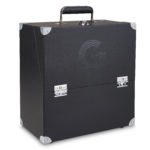This is another of those terms that has taken on special relevance in the last few years as more and more fans of a certain genre of music have become more hip to hop of the lingo. In this sense, it can certainly feel like a more recent trend or even a coinage from the last decade or so, though crate digging has in fact been around about as long as vinyl records themselves.
Back in the day, all records would be stored in crates, a cheap and easy format in which to hold a large number of records in one place. The caveat for this way of holding and presenting records to customers was the down and dirty nature of looking for records that this encouraged, though this wouldn’t have been a problem for some.
In the modern day, the term ‘crate digging’ has come to describe the action of scouring the bargain bins and second hand sections for a piece of overlooked gold, an overlooked piece of music that an aspiring or established producer might turn from garbage bin to gold. This has taken on more and more relevance in an age where even clearing the most obscure sample of its copyright becomes an ever more cumbersome and expensive task.

Where to go Crate Digging
As this is such a democratised art form, you can go crate digging just about anywhere that you can find records. The traditional idea of crate digging is that you take it back to how it used to be. Since records were initially presented in such crates, a crate digger will want to get down and dirty with these kinds of records, typically in the bargain bin section of a store selling records, or in cheap plastic crates beneath the display of newer records.
No matter the format, the important part seems to be the eschewing of the flashier display cases in favour of these old classic crates, oft overflowing with records that no one quite wants or loved enough to keep, and that might in this way harbour hidden gems, which might not only hold sounds unheard on other producer’s beats but also which will hopefully be so obscure as to be devoid of copyright issues and complaints of ownership.
Any good record store worth their salt will have a bargain section like this running in tandem or parallel to the surface level of the store, usually filling boxes and / or crates beneath the surface level displays full of these kinds of more obscure used records. It’s very easy to miss them, in fact, as they are placed on the floor underneath the usual displays to maximise space, but their placing here should not act as an overall indicator to their overall value.
Records stores are not the only place you might go crate digging; essentially anywhere that sells records is go for the act. Yard sales and boot sales or bazaars are ample for this kind of thing, littered as they are with all of the bits and bobs that people no longer want and are willing to sell for dirt cheap. Don’t be afraid to get creative with where you go crate digging!
How to Go Crate Digging
This is an area still ripe for the democracy and agency of the consumer, so there is no one holistic way to go crate digging. However, there are a few things you can do to clue yourself up enough that you might improve your chances of stumbling across some hidden gold.
Simply knowing your craft as much as possible will guarantee you are at least making more well informed choices out in the field, meaning that even when you are just buying from the usual record displays, you are doing so with your head screwed on. This means scanning all of the information on a record and coming to learn through the liner notes a number of usual suspects whose presence on a recording tends to indicate that it’s bound to be a good time.
Though part of the fun of crate digging is the sheer randomness of not quite knowing what you are getting, most record stores will tend to have an in house turntable that you can use to check the contents of a record in question. When I am record shopping, what with the advent of other technologies, I tend to search for a record on my phone and listen briefly before making a decision. If you are crate digging right you will often come across records which you can’t even find a trace of on the internet, so using the turntable in the record store might prove the only way of getting a sneaky preview.
Many of the best producers looking for obscure samples won’t sample the goods, but will simply know exactly what to look for, certain indicators telling them whether or not to buy a record. You, as a crate digger, will want to and will eventually develop your own intuitive internal language around it based on various successes and failures in the field.
Final Tones
So, there you have it, a comprehensive and, I hope, helpful first step on your journey towards being a master crate digger. Remember, even the best of them make mistakes sometimes, it’s all about the chance of it, the excitement of not knowing quite what you’re going to get. Get creative with it, crate digging wherever you go!
FAQs Crate Digging
A crate digger is simply someone who is partial to digging in crates of records, looking for gold. This will tend to be in record stores, in the bargain bins beneath the surface displays, where the oft unloved, preloved, or obscure lurks, waiting for any aspiring or established producer to ‘flip’ a sample of it and turn it into a new track.
Yes and no. The vinyl record as a format for distributing and consuming music is making a massive comeback, almost entirely unprecedented in fact. Certainly, no one could really have predicted that such an outdated and backward musical medium could have such a huge resurgence in the 21st century. However, this doesn’t necessarily translate to record stores making a comeback. Sure, they may have done towards the beginning, but with the ever advancing march of internet sales, there is less and less of a place for physical stores to exist. Most of those still in action are able to do so by selling coffee etc on the side.







